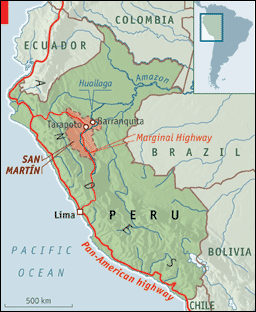Land rights in Peru
Whose jungle is it?
March 19 , 2009 - The Economist
A scramble for land sets investors against locals
 TARAPOTO -- THE San Martín region in northern Peru is a large swathe of tropical land the size of Costa Rica where the eastern foothills of the Andes merge with the Amazon jungle. It used to be best known for drugs and terrorism: its rugged hillsides were perfect for coca, the raw material for cocaine, and as hideouts for the Maoist Shining Path guerrillas. Now that both have largely disappeared from the area, and long stretches of the Marginal Highway, a road connecting it to the Pacific coast, have been surfaced with asphalt, San Martín is seeing a scramble for land.
TARAPOTO -- THE San Martín region in northern Peru is a large swathe of tropical land the size of Costa Rica where the eastern foothills of the Andes merge with the Amazon jungle. It used to be best known for drugs and terrorism: its rugged hillsides were perfect for coca, the raw material for cocaine, and as hideouts for the Maoist Shining Path guerrillas. Now that both have largely disappeared from the area, and long stretches of the Marginal Highway, a road connecting it to the Pacific coast, have been surfaced with asphalt, San Martín is seeing a scramble for land.
While some neighbouring countries shun multinationals and harry local businesses, Peru’s president, Alan García, is convinced that private investment, both local and foreign, is the best way to haul his people out of poverty. His government, like its similarly-minded predecessor, has granted land concessions for oil and gas exploration, mining, biofuel crops and logging. The problem is that many of these are superimposed on towns, farms and natural parks. That is a recipe for conflict.
“About a quarter of our region has been granted in concession without anyone letting us know,” says Ulderico Fasanando, an official in the regional government. Locals are particularly worried about the fate of the Cordillera Escalera, a mountain range that is the water source for Tarapoto, the region’s largest town, and is home to villages of small-scale farmers and several endangered wildlife species, including the spectacled bear.
A local request to declare the range a protected environment was filed in 2000, but not approved by the government in Lima until 2005. In the interim, the government had included the area in an oil and gas concession now held by a consortium involving Canada’s Talisman Energy, Brazil’s Petrobras and Spain’s Repsol. Last month the Constitutional Tribunal, Peru’s highest court, ruled that exploration should halt in the protected area while the government comes up with a development plan. Greens and civic groups in San Martín fear that this will approve exploration, and are gearing up for a long and nasty fight. Semira Pérez, the leader of this coalition, complains of graffiti labelling her a terrorist, and of death threats.
Another dispute involves a plan to plant 3,000 hectares (7,400 acres) of oil palms for biofuel in Barranquita by the Romero group, one of Peru’s biggest business conglomerates. Opponents say the government illegally redesignated this land from forest to farmland, and complain of harassment by the company. The Romero group says the project was approved by local, regional and national government. But Barranquita’s mayor says he rescinded the permit granted by his predecessor, while the regional government has fired the official who granted permission.
Part of the problem in San Martín is that fewer than half of landowners have titles proving their ownership. Mr Fasanando says that this ambiguity encourages land grabs, migration and deforestation. Previous governments have fitfully undertaken titling programmes, inspired by Hernando de Soto, a Peruvian economist who argues that enforceable property rights are the key to development. But titles have mainly been given out in the cities.
A law approved last month seems to encourage landgrabbing. It legalises squatter settlements set up on private land before 2005—the eighth such measure in the past four decades. The law allows the compulsory purchase of such lands by the government. Another new law does the same for squatters on public land. More than 250,000 properties are involved.
Mainly because it welcomes investors, Peru’s economy has grown strongly, more than doubling in size since 1993. According to several forecasters, it is the only one among the larger Latin American economies that will grow this year. But growth has gone hand-in-hand with protests, especially in the interior of the country. Sorting out land rights might bring harmony to the Peruvian cacophony.